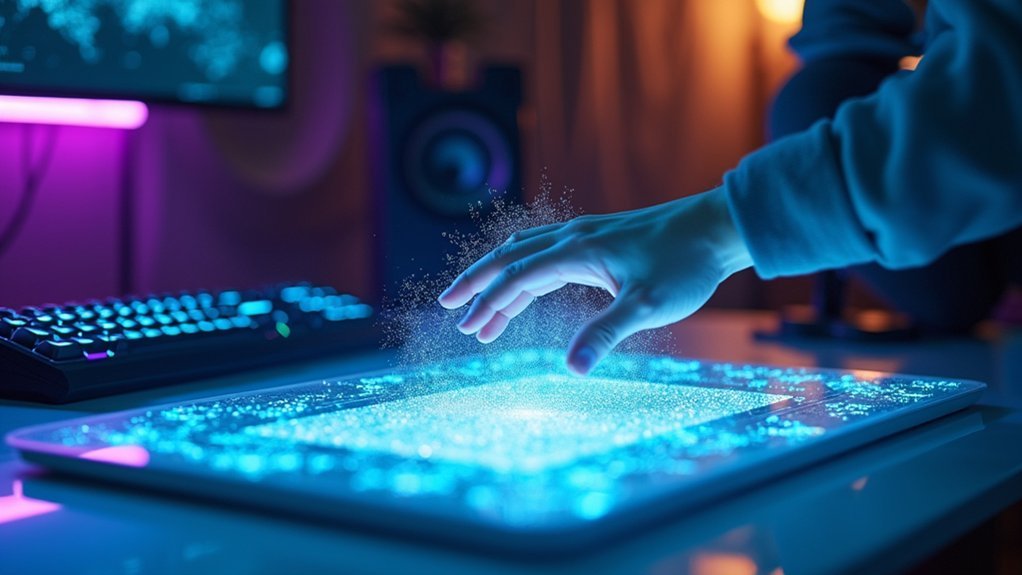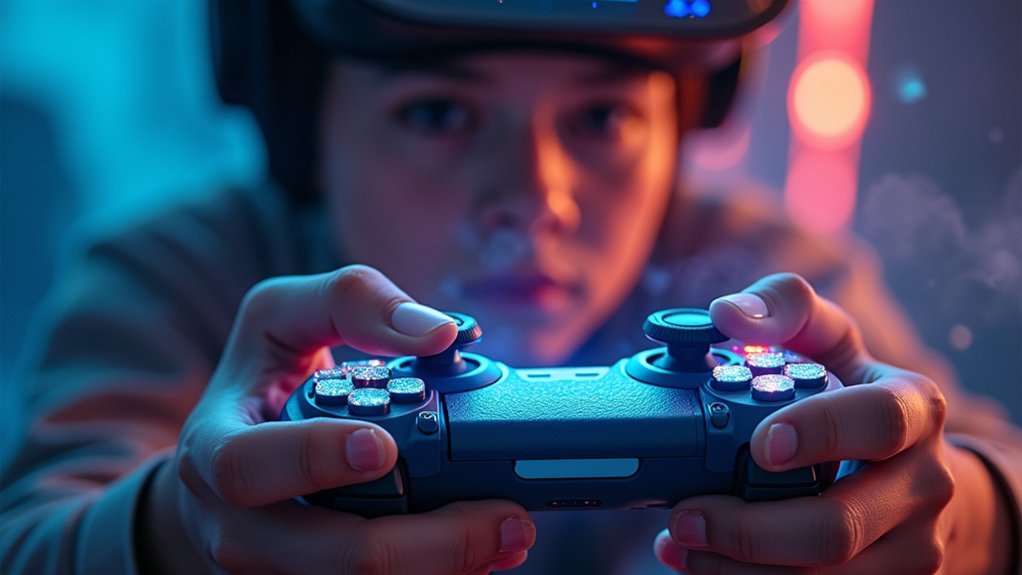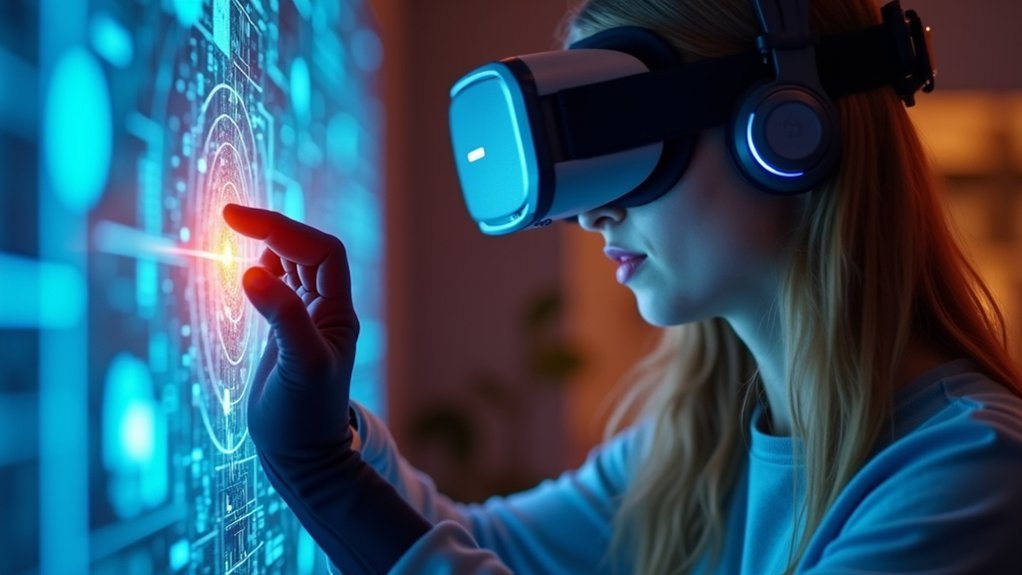You can now feel authentic weight, texture, and resistance in virtual gaming through advanced haptic technology that converts electrical signals into precise mechanical sensations. Modern haptic gloves capture individual finger movements while simulating material properties, replacing crude vibrations with realistic touch feedback. Ultrasound systems create mid-air sensations without physical contact, while sophisticated actuators deliver vibrotactile and force feedback for genuine texture experiences. These innovations transform VR from passive observation into active participation, and there’s much more happening in this evolving field.
The Science Behind Haptic Feedback in Gaming

When you press a button on your controller and feel a subtle rumble as your character’s sword clashes with an enemy’s shield, you’re experiencing haptic feedback—a technology that converts electrical signals into mechanical motion through specialized actuators.
These actuators create sensations that simulate textures, impacts, and vibrations, making your virtual experiences feel remarkably real.
Research shows that synchronous visuo-tactile stimuli enhance body ownership and presence in virtual environments, making touch essential for immersion.
Modern haptic feedback systems go beyond basic vibrational motors, incorporating sophisticated devices like haptic gloves and motion capture suits that deliver nuanced tactile sensations.
Companies like Ultrahaptics even use ultrasound technology to create “mid-air touch” experiences, letting you feel virtual objects without physical contact, revolutionizing how you interact with digital worlds.
How Tactile Sensations Enhance Virtual Reality Experiences
Although your eyes capture stunning visual details in virtual reality, it’s your sense of touch that truly convinces your brain you’re somewhere else entirely. Tactile sensations transform VR from passive observation into active participation, creating authentic embodiment experiences that make virtual environments feel real.
Technologies like Ultrahaptics revolutionize this experience by generating mid-air touch sensations through ultrasound, letting you feel virtual textures without physical contact. When synchronized properly, these tactile inputs alter your body ownership perceptions, making you believe you’re actually inhabiting your virtual avatar.
Key benefits of tactile sensations in VR include:
- Enhanced presence through realistic environmental feedback
- Improved embodiment via synchronized touch responses
- Better social interactions in virtual spaces
- More engaging gameplay through varied physical sensations
Breaking Down the Technology: Ultrasound and Touch Simulation

You’ll find that ultrasound haptic technology works by directing focused sound waves from strategically positioned speakers to create precise touch sensations on your skin.
The system doesn’t require any physical contact—instead, it generates everything from gentle vibrations to intense pressure effects in mid-air within about a meter’s range.
These advances in touch simulation let you feel virtual textures, shapes, and environmental elements like raindrops or solid barriers with remarkable realism.
Ultrasound Haptic Mechanics
While traditional haptic feedback relies on physical contact through controllers or wearable devices, ultrasound haptic technology breaks this barrier by creating tactile sensations in mid-air. You’ll experience touch without touching anything physical.
This system works through precise engineering that transforms sound waves into tangible sensations:
- Speaker arrays emit focused ultrasound waves toward your skin
- Sound wave convergence creates pressure points that stimulate nerve endings
- Dynamic modulation adjusts wave intensity to simulate different textures and forces
- Real-time tracking follows your hand movements to maintain consistent feedback
The ultrasound reflects safely off your skin’s surface, generating sensations within one meter of the speakers. You’ll feel everything from gentle rain to electric pulses, though the technology can’t simulate solid barriers or heavy resistance yet.
Touch Simulation Advances
Recent breakthroughs in ultrasound haptic technology have transformed how developers simulate touch sensations in virtual environments.
You’ll experience remarkably nuanced feedback when interacting with virtual objects, from gentle vibrations to intense tactile effects. The touch simulation creates realistic textures and dynamic responses that make your gaming sessions feel genuinely immersive.
Within one meter of the ultrasound speakers, you can feel everything from rough surfaces to smooth materials.
While the technology can’t simulate solid barriers, it excels at delivering varied sensations that enhance your connection to virtual worlds.
As costs continue dropping, you’ll see this touch simulation technology becoming standard in gaming hardware, revolutionizing how you experience virtual environments across multiple entertainment platforms.
From Controllers to Gloves: Evolution of VR Input Devices
As VR technology has matured, the devices you use to interact with virtual worlds have transformed dramatically from primitive button-based controllers to sophisticated haptic gloves that let you actually feel what you’re touching.
The leap from clicking buttons to actually feeling virtual objects marks a revolutionary moment in human-computer interaction.
This evolution represents a fundamental shift from digital approximation to physical simulation, where your natural hand movements become the primary interface.
Key developments in VR glove technology:
- Finger tracking precision – Modern VR gloves capture individual finger movements and gestures with remarkable accuracy.
- Haptic feedback systems – Advanced tactile responses simulate texture, resistance, and material properties.
- Ultrasonic haptics integration – Companies like Ultrahaptics deliver touch sensations without physical contact.
- Motion tracking fusion – Seamless combination of hand position and gesture recognition.
Companies like HaptX are pioneering these immersive technologies, making virtual interactions feel increasingly natural and realistic.
Feeling Textures and Temperatures in Digital Worlds

Beyond simply tracking your hand movements, today’s most advanced VR systems let you experience the physical properties of virtual objects through sophisticated sensory simulation. You can now feel the rough bark of a digital tree or sense the warmth radiating from a virtual campfire through cutting-edge haptic technology.
Ultrahaptics creates mid-air touch sensations using ultrasound waves, while electronic skins simulate temperature changes and impacts on your body. These systems reproduce nuanced textures and thermal feedback, making virtual environments incredibly lifelike.
| Technology | Sensation Type | Experience |
|---|---|---|
| Ultrahaptics | Surface Texture | Rough/Smooth Feel |
| Electronic Skins | Temperature | Hot/Cold Objects |
| Haptic Gloves | Material Density | Hard/Soft Touch |
| Thermal Feedback | Heat Transfer | Warmth/Coolness |
This real-time tactile feedback strengthens your sense of presence and embodiment in digital worlds.
The Role of Touch in Creating Authentic Virtual Environments
When you reach out to touch a virtual object and feel nothing but air, the illusion of being transported to another world instantly shatters.
Touch serves as the foundation for authentic virtual environments, creating experiences that genuinely feel real rather than simulated.
Research demonstrates that synchronous visuo-tactile stimuli fundamentally alter your perception of bodily boundaries, making you feel genuine ownership over virtual objects.
This sensory integration transforms passive observation into active embodiment within digital spaces.
Current VR systems’ basic haptic feedback methods severely limit touch authenticity, but emerging technologies promise revolutionary improvements:
- Electronic skins replicate complex tactile sensations across larger surface areas
- Ultrasound-based feedback systems deliver precise, localized touch without physical contact
- Performer-facilitated touch increases social presence in interactive gaming experiences
- Advanced haptic gloves provide finger-level texture and resistance feedback
Current Limitations of Traditional VR Systems
Despite decades of advancement, traditional VR systems still fall short of delivering truly immersive experiences due to their overwhelming emphasis on visual and auditory stimulation while neglecting tactile feedback.
When you reach out to touch a virtual object, you’re met with empty air or crude vibrations that break immersion instantly. Most systems rely on basic vibrotactile motors that can’t simulate realistic textures, temperatures, or forces you’d expect from real interactions.
Current VR haptic feedback remains primitive, offering only crude vibrations that fail to simulate realistic textures, temperatures, or physical forces.
Your controllers create a barrier between you and virtual environments, preventing natural touch-based exploration. Without synchronized visual and tactile stimuli, you lose essential body ownership and spatial presence.
This disconnect becomes obvious when you try grabbing virtual objects—you see your hand making contact, but feel nothing meaningful, creating an unconvincing experience that constantly reminds you you’re in a simulation.
Advanced Haptic Gloves: Features and Capabilities
Revolutionary haptic gloves are transforming VR interaction by replacing crude controller vibrations with sophisticated tactile feedback systems that let you actually feel the virtual world.
These advanced devices combine multiple actuator types and precision sensors to deliver realistic touch sensations that sync perfectly with your visual experience.
Modern haptic gloves offer unprecedented capabilities:
- Vibrotactile and force feedback – You’ll experience genuine resistance when gripping objects and feel varied textures through controlled vibrations.
- Lightweight ergonomic design – Extended gaming sessions remain comfortable while maintaining precise motion tracking accuracy.
- Cross-platform compatibility – Most models integrate seamlessly with popular VR systems for immediate setup.
- Advanced sensation research – Developers are actively working toward replicating complex feelings like temperature variations and intricate surface textures.
Real-World Applications Beyond Gaming Entertainment
While haptic gloves are revolutionizing gaming experiences, their impact extends far beyond virtual entertainment into fields that directly improve human lives.
You’ll find this technology transforming stroke rehabilitation, where patients regain sensory and motor functions through simulated tactile experiences. In healthcare, doctors can now perform virtual examinations with realistic touch sensations, improving diagnostic accuracy during remote consultations.
The automotive industry benefits from mid-air haptic feedback, enabling gesture controls that reduce physical button dependency.
Educational institutions use this technology to enhance anatomy teaching, letting students feel virtual models for better understanding of complex structures. You can even experience tactile sensations in social media interactions, sharing touch-based emotions in virtual environments that strengthen human connections across distances.
The Future of Multi-Sensory Virtual Reality Experiences
You’ll soon experience gaming through electronic skin technology that wraps around your body, transmitting precise tactile feedback directly to your nervous system.
This advancement will transform how you interact with virtual worlds, making every surface texture and environmental condition feel authentically real against your skin.
As haptic gaming continues evolving, you’ll find yourself completely immersed in multi-sensory experiences where the boundary between virtual and physical sensation virtually disappears.
Electronic Skin Technology
As virtual reality inches closer to replicating real-world sensations, bioengineering professor John Rogers has developed electronic skin technology that transforms how you’ll experience touch in digital environments.
This advanced silicon gel smart skin simulates tactile sensations, temperature changes, and impacts in real-time, creating authentic virtual touch experiences you can share with other participants.
The technology enhances your sense of presence and embodiment in VR through:
- Real-time tactile feedback that responds instantly to virtual interactions
- Multi-user touch sharing enabling synchronized sensations across participants
- Temperature simulation adding thermal dimensions to virtual experiences
- Lightweight wireless design with improved range and functionality
This electronic skin technology greatly boosts user engagement and emotional responses, making virtual gaming moments feel genuinely immersive and authentic.
Haptic Gaming Evolution
Building on electronic skin breakthroughs, haptic gaming evolution now extends beyond surface contact to create mid-air sensations that’ll transform your virtual reality experiences. Companies like Ultrahaptics use ultrasound waves to generate tactile feedback without physical contact, letting you feel textures and impacts floating in space.
This haptic gaming technology creates authentic touch experiences that greatly boost your sense of presence and embodiment. You’ll feel genuine interactions as lightweight, affordable haptic suits deliver precise sensory feedback throughout gameplay.
| Gaming Experience | Traditional VR | Haptic-Enhanced VR | Impact Level |
|---|---|---|---|
| Object Interaction | Visual Only | Touch + Visual | High |
| Combat Feedback | Controller Vibration | Full-body Impact | Extreme |
| Texture Recognition | None | Realistic Feel | Moderate |
| Environmental Awareness | Audio/Visual | Multi-sensory | Revolutionary |
These multi-sensory experiences extend beyond gaming into healthcare, education, and entertainment sectors.
Frequently Asked Questions
Can You Feel Touch in Virtual Reality?
You can feel limited touch in VR through haptic controllers and vibration feedback, but it’s not fully realistic yet. Advanced technologies like electronic skins and ultrasound are improving tactile sensations considerably.
Can VR Make You Lose Touch With Reality?
You can lose touch with reality during intense VR sessions, especially when haptic feedback creates convincing tactile experiences. Extended immersion blurs physical boundaries, making you forget your actual surroundings and body position.
What Is the Feeling of Presence in Virtual Reality?
You’ll experience presence as the psychological sensation of actually being inside a virtual environment rather than viewing it from outside. Your brain perceives the digital world as real, creating genuine spatial awareness.
Why Does Virtual Reality Feel Real?
Your brain’s convinced by synchronized visual and auditory signals that create believable environments. When you see and hear coordinated digital information, your senses can’t distinguish it from reality, making virtual experiences feel genuinely authentic.
In Summary
You’re standing at the edge of a haptic revolution that’ll transform how you experience virtual worlds. Soon, you’ll feel raindrops on your skin, texture rough stone walls, and sense temperature changes in digital environments. As developers refine ultrasound technology and advanced haptic gloves, you’ll discover gaming isn’t just about what you see and hear anymore. Your sense of touch will reveal unprecedented immersion, making virtual reality feel genuinely real.





Leave a Reply